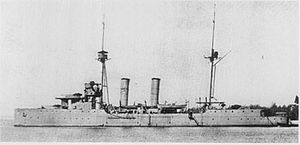 Clas Fleming c. 1914–1915
| |
| History | |
|---|---|
| Name | Clas Fleming |
| Namesake | Clas Fleming |
| Ordered | 17 May 1910 |
| Builder | Bergsund Finnboda, Stockholm |
| Launched | 14 December 1912 |
| Commissioned | 1914 |
| Refit | Reconstructed, December 1939–August 1940 |
| Stricken | 1959 |
| Fate | Sold for scrap, 9 November 1960 |
| Badge |  |
| General characteristics (as built) | |
| Type | Cruiser-minelayer |
| Displacement | 1,550 long tons (1,575 t) (standard) |
| Length | 80.2 m (263 ft 1 in) |
| Beam | 10.4 m (34 ft 1 in) |
| Draft | 4.3 m (14 ft 1 in) |
| Installed power |
|
| Propulsion | 2 shafts; 2 direct-drive steam turbines |
| Speed | 20 knots (37 km/h; 23 mph) |
| Complement | 161 |
| Armament |
|
| Armor |
|
HSwMS Clas Fleming was a cruiser-minelayer built before World War I for the Royal Swedish Navy. Completed in 1914, the ship performed limited neutrality patrols in the Sea of Åland and the northern reaches of the Stockholm Archipelago during the war. She was placed in reserve in 1917 to be modified to make laying mines safer and remained in that status until the beginning of World War II in 1939 to save money. Clas Fleming was activated for a short time that year to lay defensive minefields before she began a reconstruction that installed an early version of gas turbines, the first warship in the world to be so equipped. After her sea trials were completed in 1940, she was on active service for the rest of the war. Clas Fleming was again reduced to reserve at that time and did not leave the dockyard before she was stricken from the navy list in 1959. The ship briefly served as a target ship before being sold for scrap the following year.